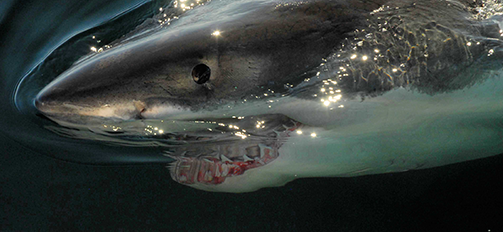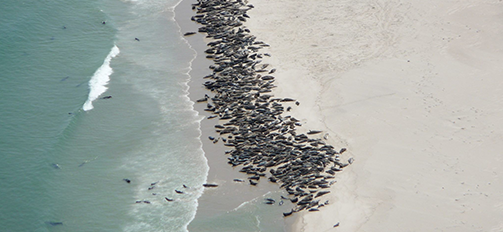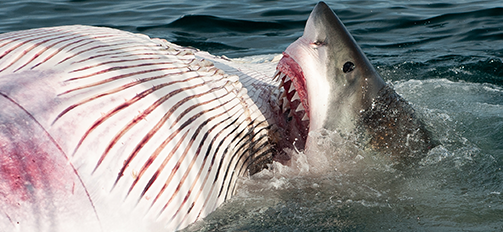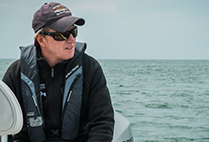Despite the four-foot swells, the captain holds the boat steady
as Skomal maneuvers a 14-foot rod with a GoPro on one end, handling it like a tightrope walker using a pole for balance. He lowers the camera into the water, filming the shark’s movements, if only briefly. Their dance lasts all of 30 seconds before the shark slides deeper into the Atlantic.
“That sucker had girth!” Skomal (GRS’06) calls to the boat’s crew, who hurry to note the animal’s size and location. The predator was one of three white sharks—the name preferred by scientists—tracked that June morning, a slow day by Skomal’s standards. Some days, especially later in the season, the researcher tracks as many as 23.
In recent years, Cape Cod has become the summer home to a growing population of white sharks—80 were identified in 2014, 141 in 2015, and 147 in 2016. They come to feast on a burgeoning population of seals, and they are arriving in such numbers that some scientists are now calling the area the sixth white shark hub in the world, joining places like Mexico’s Guadalupe Island and South Africa’s Seal Island, and making it the only aggregation site—an area where sharks reliably gather—in the North Atlantic.

“To learn about these animals, and how they live, is really quite rewarding,” says Greg Skomal. “The data we collect will ultimately conserve the species, and I like that.” Photo by Wayne Davis
Skomal, who has studied sharks of all kinds for three decades, is the North Atlantic’s go-to guy for separating fact from fiction about white sharks. He is a senior fisheries biologist at the Massachusetts Division of Marine Fisheries, and his Kennedy-like looks and easy manner have helped him earn appearances on the Discovery Channel’s Shark Week specials.
Mainly, though, Skomal is a researcher. In 2013, he used an autonomous underwater vehicle to observe white shark predatory behavior well below the surface, the first time scientists had been able to do so. In 2015, he published a study in Marine and Freshwater Research showing that white sharks grow more slowly and mature sexually much later than scientists had previously thought. This season, he is testing a tethered balloon system with cameras trained on areas like that off Monomoy Island to keep an eye out for sharks when scientists can’t be out there. Skomal, who has contributed to more than 60 scientific papers, is on the adjunct faculty at the University of Massachusetts and is an adjunct scientist at the Woods Hole Oceanographic Institution.
Working with the Massachusetts Marine Fisheries, he is midway through two major multiyear studies of the population, migration, and behavior of white sharks along Massachusetts beaches and the East Coast of the United States. The researchers hope that their findings will help protect the ancient predators, whose ancestors plied the seas more than 400 million years ago, from today’s high-tech shark hunters. Each year, researchers estimate, at least 100 million sharks are killed worldwide, some for sport, some to eat (shark fin soup is a delicacy in some parts of the world), and sometimes accidentally in fishermen’s bycatch. The white shark is marked as “vulnerable” by the International Union for Conservation of Nature’s Red List of Threatened Species. If scientists can learn where sharks feed and breed, Skomal says, efforts can be made to clear those areas of hazards, like fishing nets. He hopes his research will contribute to both domestic and international efforts to achieve sustainable shark populations.
Colleague Lisa Natanson, a National Oceanic and Atmospheric Administration fisheries biologist and a coauthor of Skomal’s paper on age and sexual maturity, says his work is crucial to New England’s ecology. “Are the sharks coming back? Were they here in these numbers before? It’s an ecosystem balance,” she says. “There is also a general safety concern, because it’s the Cape, so it’s important to know about the animals’ behavior. Greg is in a great situation to be able to do that.”
Skomal points out that less is known about the behavior of white sharks in the North Atlantic than is known about sharks elsewhere, and there are many questions yet to be answered.
“For hundreds of years, we viewed these animals as pests that need to be eradicated,” he says. “But the public attitude has dramatically changed over the last 20 years. I’m a person who believes that the more people know about these animals, the more they will revere them, as opposed to fear them. The more we learn about sharks, the more we realize they are an integral part of the marine ecosystem.”
The Greg Skomal seen by millions on Shark Week’s Shark Vortex special—gregarious and charming—is only one version of the man. Off camera, he’s a total fish nerd, one who has published 11 books on keeping an aquarium.
As a kid growing up in Connecticut, Skomal had two heroes: Jacques Cousteau, the famous undersea explorer, writer, and star of two TV documentary series, and the fictional oceanographer Matt Hooper, who helps outsmart the man-eating great white in Jaws.
“When I was 12 or 13, I wanted to study sharks, but I figured when I got old enough to do it, it would all be done,” Skomal says with a laugh. “How naïve was I? A lot of kids come up to me and say, ‘I want to study sharks but you’re going to do it all.’ And I say, ‘Are you crazy? I’m just scratching the surface.’”
As an undergraduate at the University of Rhode Island, Skomal interned at the National Marine Fisheries Service lab in Narragansett and pestered the scientists, eventually talking his way into a technician’s job in their lab. In 1987, he joined the Massachusetts Division of Marine Fisheries, where he studied several kinds of fish—white marlins, bluefin tuna, blue sharks. White sharks, the Holy Grail to many marine biologists, were a distant dream.
Close
Katharine, the Great White
The map below shows the travels of Katharine, a 14-foot long, 2,300-pound white shark that was tagged in summer of 2013. Large circles show “seal haul-outs,” or places where seals are known to congregate and thus attract sharks, like Katharine. Smaller concentric circles show places where Katharine has surfaced. Click on those circles to see dates of her surfacings. In the four years since Katharine was tagged, she has traveled more than 32,000 miles.
Map Legend
 Katharine surfaced
Katharine surfaced Seal haul-out location
Seal haul-out location
CLick the circles below and move around the map for more information about Katharine’s path.
Skomal remembers—in the early 2000s, when no more than one or two white sharks were spotted around Cape Cod each year—half-eaten, 800-pound gray seals started washing up on beaches. “There’s not much that will take a big, two-foot diameter bite out of a seal like that,” says Skomal, who was then pursuing a PhD in the BU marine program. “A seal is a top predator itself. So it was pretty apparent to us, looking at the big wounds on those animals, that there were white sharks out there.”
Confirmation came when a friend called to tell Skomal that a white shark was stuck in a tidal lagoon on Naushon Island near Woods Hole.
A doubtful Skomal headed down to check it out. What he saw was a 14-foot, 1,700-pound female, eventually named Gretel after the girl in the Brothers Grimm fairy tale. Gretel spent two weeks in the lagoon while marine biologists tried to coax her out. When Skomal tagged her with a tracking device in her dorsal fin, he was ecstatic, eager to find out where the shark would go, only to learn that the transmitter had failed 45 minutes after the shark left the lagoon.
“It was the highest high of my career at the time, and then the lowest low,” he says. “But still, it was eye-opening that we had a big, 14-foot white shark swimming in Massachusetts waters.”

Researcher Greg Skomal hopes that his findings will help protect sharks. Each year, about 100 million are killed for sport, for food, and sometimes by accident. Photo by Greg Skomal
Five sharkless years followed. Then, on Labor Day weekend 2009, a spotter pilot reported two white sharks near big seal haul-outs—incidences of seals temporarily leaving the water—on Monomoy Island. “That was the kickoff,” Skomal says. “We went out over the course of the next couple of days and tagged five sharks.”
These days, visitors to some of Cape Cod’s most popular beaches are greeted by large, colorful signs warning: “Great white sharks live in these waters. Sharks prey on seals. Avoid swimming near seals.”
That’s not always as easy as it sounds. The gray seal population on the Cape is said to be as high as 50,000; the marine mammals have rebounded after being hunted nearly to the point of extinction. And while there hasn’t been a fatal shark attack in Massachusetts since 1936, there have been at least two close calls—in 2012, a white shark bit a Colorado man on the leg while he was swimming near seals off a Truro beach, and in 2014, two women kayaking near seals in Plymouth were rammed and thrown off their boats by a white shark.
“When you put white sharks in the same waters where there are humans, you are going to increase the potential for an interaction,” says Skomal. “That’s going to happen; that’s what’s happened all over the world. It’s not likely to happen, but I want to collect data that is going to augment public safety.”
With no sharks in sight at 10 a.m., Skomal leans over the side of the boat and hauls up a large yellow buoy marked Delta 4 to download information that has been transmitted to it by tags on passing sharks. Acoustic tags, which last up to 10 years, broadcast an identifying signal (a “ping”) whenever a shark swims within 100 to 200 yards of buoys equipped with receivers. The buoys are scattered across Massachusetts waters, and similar tags are used by marine biologists working with all kinds of fish. A white shark’s acoustic tag, for example, could ping a receiver set up by a Duke University researcher studying sturgeon. When scientists share the data, Skomal says, it’s possible to piece together the coastal movements of individual fish.
Satellite-linked tags, each with a serial number, relay broad-scale, three-dimensional movement data. Skomal combines the information from the acoustic and satellite-linked tags to study spatial ecology, which includes the depth of sharks as well as their geographic location.

A burgeoning population of seals has attracted more white sharks on Cape Cod. Photo by Pilot George Breen
Seals
- 2012: 12,730
- 2015: 17,060
Cynthia Wigren, president and cofounder of the Atlantic White Shark Conservancy, a nonprofit that promotes white shark research, education, and public safety, matches up each serial number with a shark. “Omar was here today at 6:18 a.m. We saw him Monday, too,” she calls out, typing away on a spreadsheet. “James!” The 15-footer is a favorite because he is not easily spooked by the boat when they come across him.
An hour later, word arrives from spotter pilot Wayne Davis that a shark is a quarter mile off Nauset Beach, and the boat heads in that direction. Wigren lowers a hydrophone into the water and listens through earphones. Just crackling. If the shark were tagged, there would have been a distinctive sound. The silence tells the researchers that a stranger has entered their waters.
Skomal’s data—stats about each shark’s sex, size, behavior, and location, as well as water conditions—are collected twice a week from mid-June through October on board the Aleutian Dream. The Massachusetts Division of Marine Fisheries white shark research relies on outside funding, and so while Skomal’s salary comes from the state, his research and some of his equipment are supported by the Atlantic White Shark Conservancy.
New sharks are filmed and identified by distinctive features, like the location and curve of the line that divides their gray tops from their white bellies. Many sharks also have identifying scars, often from a seal that fought back, and some are missing fins because of interactions with other sharks. All of the shark profiles are carefully catalogued, and help to estimate the white shark population on the East Coast. “Our population study is important because from a conservation point of view, it gives you a basis from where we are starting. We can look at the population and model how it will change in the coming years,” says Skomal, who works on the project with UMass Dartmouth PhD student Megan Winton.
He and the crew have tagged 132 white sharks (96 with acoustic tags and 36 with satellite tags), and have identified more than 280. They are convinced that the Cape’s shark population is much larger than that, because only about one-third of the sharks they encounter has already been identified. He and other researchers have noted greater numbers of smaller sharks, including juveniles, which implies that the population is rebuilding. They have also observed a midsummer migration of sharks northward from Chatham, to Orleans, and then to Provincetown, and his acoustic tag data suggest that some of the bigger sharks are lingering, possibly establishing territory.
The tag data indicate that most sharks are hanging around Cape Cod in the summer and moving to Florida in the winter. And while many sharks do follow that pattern of migration, recent research suggests that many others move into the open Atlantic and wander the ocean.

Skomal has observed a midsummer migration northward, from Chatham to Provincetown, with some larger sharks lingering, possibly establishing territory. Photo by Pam King
Skomal recalls one of his favorite white sharks, Lydia, who he first met in 2013 near Jacksonville, Fla., as she roamed the mouth of the St. Johns River looking for dolphins to eat. He helped fit the 14-foot, 2,000-pound female with a satellite tracking tag, and she has since traveled not only up and down the East Coast, but well offshore as far as the mid-Atlantic ridge, where, for some reason, she dives as deep as 3,000 feet.
Skomal says this diving behavior of white sharks in the open Atlantic is most likely so they can feed on deep-sea critters (like the elusive giant squid). In the Pacific Ocean, he says, large white sharks routinely converge on an area known as the “white shark café,” but in the Atlantic, the sharks are less predictable.
“There are a lot of hypotheticals,” Skomal says. “We can assume they are feeding, but is there some reproductive component to this migration that we don’t know about? We do know it costs energy to do it. When you move out to the open Atlantic and dive down to great depths, you are expending a large amount of energy. So that means it is ecologically important for them to be doing it.”
For researchers like Skomal, such questions are their own reward, offering more to learn about a lifelong passion. And on a more practical note, Skomal’s tags have the potential to make beaches safer for swimmers. Imagine, he says, if a beach manager working in the Cape Cod town of Orleans could be alerted when a shark nears her beach. Skomal has hard scientific evidence that that’s something beachgoers want to know. A shark warning app, Sharktivity, developed by the Massachusetts Division of Marine Fisheries, the Atlantic White Shark Conservancy, and a regional working group made up of Cape Cod towns and the Cape Cod National Seashore, has been downloaded more than 100,000 times.
“Of course,” he says, “that provides a partially false sense of security. We don’t tag them all.”



















































Fascinating research and documentation. Congratulations and keep up with the good study. Thanks for sharing. Ilean
Impressive media package, informative, and well-written!